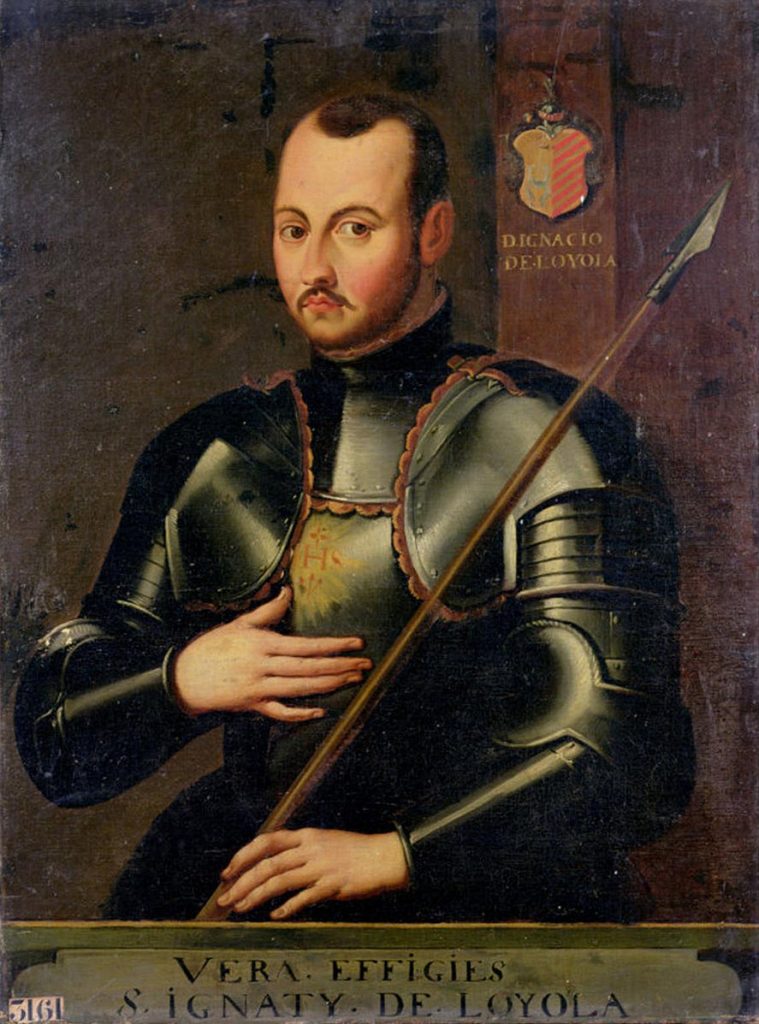St. Ignatius was a Spanish priest who founded the Society of Jesus, or Jesuit Order, in 1540. He intended the society to be servants of the pope, and therefore of the universal Catholic Church. The Jesuits have been given credit for responding to the Protestant Reformation and for winning back to the Catholic fold many of the people who had left the church.1 St. Ignatius, known as Inigo in Spanish, lived a life of chivalry in his early years. Before devoting his life to God, he was a dedicated solider, and it wasn’t until he came to a near death experience that he decided to change his life.
In 1521, Ignatius was a soldier fighting to defend the Spanish city of Pamplona alongside his master Antonio de Manrique, the Duke of Nájera, against the French. Negotiations began between the besieged Spanish and the French military leaders, and when talk of surrendering to the French came up, Ignatius was furious at the weakness of his Spanish negotiators. He wanted to defend the city or die trying.2 The French proceeded to attack the city. Unfortunately, Ignatius was shot by a cannon and was seriously injured. The cannonball had struck his legs and seriously damaged one of them. Fortunately, some French soldiers tended to his damaged leg. The soldiers saved his leg from amputation, so in return, Ignatius gave away his shield, corset, and dagger to the French soldiers. From the battlefield, Ignatius was transported to northern Spanish town of Anzuola to recover.

When Ignatius arrived in Anzuola, the doctors decided that it would take multiple surgeries to help him. First, they decided that his leg had to be broken again and his bones reset. During the first operation, Ignatius did not utter a single sound, and the only indication of pain he gave was clinched fist. The operation brought Ignatius to near death. He was advised to confess his sins to a priest, and was told that if he did not feel better, he could consider himself a dead man. That night Ignatius prayed to St. Peter and later that night he started to feel better. However, something went wrong during the second surgery. As the bones in his right leg settled, a piece of the bone had started to push itself forward from his knee creating a stub.3 Ignatius immediately demanded another operation be performed. Ignatius believed that life had no purpose if he could not prove his courage to women or wear the elegant knee-boots of the hidalgo.4 The doctors advised against this, but Ignatius insisted. Again, he did not utter a single sound during the very painful surgery. The surgery was a success, but Ignatius remained bedridden for months. When he was well enough to read, he requested books of chivalry, but there were no books of that kind in the castle. Instead, he was given The Life of Christ and The Lives of the Saints.
These two books had a great impact on his life. At first, Ignatius read these books in disgust. He dismissed the saints for the penances they performed. Slowly, the nobility of their actions grew on him. He was able to find things that he admired about them. One saint that caught Ignatius’s eye was Saint Francis. He admired St. Francis’ courage, his love of dancing, his singing, and his love for nature. These books changed the way he thought about life. He wanted to be a working servant of Christ, like St. Francis had been. While he was recovering, he saw a vision of Mary, the mother of God, and was filled with joy. This vision of Mary made Ignatius completely devote his life to God.
After he had recovered, he gave all his clothes away and became a hermit and focused on helping the sick. He wrote about his experiences, which eventually became known as the Spiritual Exercises. He knew he would need an education to help convert people, so he went to Barcelona to further his education. He became a priest in 1537. In his earlier life he had been a faithful and dedicated solider, and now he brought those same characteristics to his life in the priesthood. In 1540, Pope Paul III confirmed the formation of the Society of Jesus. Ignatius led the Jesuits along the lines of his military experience, but instead of fighting on military battlefields, they were to dedicate their military-like focus to serving the interests of God and to converting people back to the Roman church. When Ignatius died in 1556, there were one-thousand Jesuits working in Europe, Asia, and the Americas.5 The Jesuits have been known ever since for their strong belief in education and for their missionary work. Today, Jesuits can be found throughout the world, contributing to their missionary work and to their many schools.
- Salem Press Biographical Encyclopedia, 2005, s.v. “Saint Ignatius of Loyola,” by Carol S. Berg. ↵
- Hugo Rahner, St. Ignatius of Loyola: a pictorial biography (Chicago: H. Regency, 1995), 14. ↵
- Hugo Rahner, St. Ignatius of Loyola: a pictorial biography (Chicago: H. Regency, 1995), 14. ↵
- Philip Caraman, Ignatius Loyola: a biography of the founder of the Jesuits (San Francisco, California: Harper & Row, 1990), 26. ↵
- Salem Press Encyclopedia, 2015, s.v. “Society of Jesus (religious order),” by Rebecca Kraft Rector. ↵



46 comments
Carlos Hinojosa
That’s actually a very interesting story about one of our many saints. I never thought that’s how someone would decide to drop everything they own, love and cherish to join the Christian order. I honestly can’t tell you if I would ever join a order or even become a priest but I already know that if something ever happens with me, I will join an order if they would let me. Very good article and I hope to read more from you in the future.
Nathaniel Bielawski
I find it interesting how Saint Ignatius was a soldier. After all, not many priests or monks have fought in wars. Saint Ignatius’ conversion to Catholicism is very inspiring. Perhaps if more people read about the stories of other saints, it will inspire them to become Catholics.
Sara Guerrero
Wow! This is my first time learning about St. Ignatius and his story is unbelievable. I can’t imagine being struck by a cannonball, but also the pain he had to endure to save his leg. It was interesting to learn that it had to be rebroken twice, but regardless he was vey adamant in saving his leg. Of course the most intiguing part was how he went from a soldier to a priest and how the jesuits still exist today.
Hali Garcia
Great article!!! I have heard of St. Ignatius of Loyola but I have not looked into his story and I learned a lot from this article. I love learning about the saints because they have some very remarkable stories. What struck me the most was how he kept asking for surgery and his only reaction to pain was clenching his fist, this really showed his strength. It is interesting how after he saw a vision of Mary, he decided to follow God and decided to become a priest.
Giselle Garcia
I enjoy reading about conversion experiences of saints; it is so amazing how once St. Ignatius discovered St. Francis, he decided to dedicate his life to God and have St. Francis as his role model. St. Ignatius helped the poor and became a priest after he had healed from his surgeries. His founding of the Society of Jesus mirrored his earlier military experience by serving God and converting people to Catholicism during the time of the Protestant Reformation.
Zachary Kobs
St. Ignatius of Loyola was a Spanish priest and theologian who founded the Jesuit order in 1534 and was one of the most influential figures in the Counter-Reformation. From soldier to priest, St. Francis influenced a big life change. Spain was also known for its missionary, educational, and charitable works. The Jesuit order was also a leading force in the modernizing of the Roman Catholic Church.
Malleigh Ebel
St Ignatius was an amazing saint, and not a very stereotypical saint. We learned about him and the Jesuit sect of Christianity in class, but I did not know he got hit with a cannon. I loved his sense of morals and chivalry, where he gave the French soldier who helped save his leg some of his equipment in return for treating him before going back to Spain. I thought it was amazing how he turned his life into helping those who are sick and injured as well.
Roberto Rodriguez
It is always interesting to see how early (or late) in the lives of saints it took them to eventually find their calling and become “holy”. I could not help, but comparing the story of Ignatius and saint Paul, both have an amazing story of conversion that is just admirable. He went through a lot of obstacles in his life and it is good that he altered his military tactics/leadership to focus to serving the interests of God and to converting people back to the Roman church.
Samantha Bonillas
Reading about saints and how they were called to sainthood is amazing. Every saint has a different story and they weren’t “holy.” Saint Ignatius of Loyola, for example, gave up his pain to God, which lead to his devotion to Christ. Mind over matter was the mentality that Saint Ignatius of Loyola as well as other saints in the sainthood. By giving up their pain to their Savior, their devotion to God grew immensely. Well written article.
Fatima Navarro
Nice article and though a short story, interesting nonetheless. I studied at a Jesuit university when I went on an exchange study abroad program. For StMU, we have gateway/canvas where we as students can find all the needed info, assignments, grades, emails, etc, Sophia university, though, in Tokyo, had a website called Loyola. Loyola was named after St. Ignatus, that is why I found this story engaging because I learnt more about him and the reason to that website’s name.